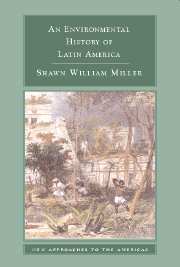Book contents
- Frontmatter
- Contents
- List of illustrations
- Acknowledgments
- Map 1 Middle America
- Map 2 South America
- Introduction: Props and Scenery
- 1 An Old World Before It Was “New”
- 2 Nature's Conquests
- 3 The Colonial Balance Sheet
- 4 Tropical Determinism
- 5 Human Determination
- 6 Asphyxiated Habitats
- 7 Developing Environmentalism
- Epilogue: Cuba's Latest Revolution
- Suggested Further Reading
- Index
3 - The Colonial Balance Sheet
Published online by Cambridge University Press: 05 February 2015
- Frontmatter
- Contents
- List of illustrations
- Acknowledgments
- Map 1 Middle America
- Map 2 South America
- Introduction: Props and Scenery
- 1 An Old World Before It Was “New”
- 2 Nature's Conquests
- 3 The Colonial Balance Sheet
- 4 Tropical Determinism
- 5 Human Determination
- 6 Asphyxiated Habitats
- 7 Developing Environmentalism
- Epilogue: Cuba's Latest Revolution
- Suggested Further Reading
- Index
Summary
Every time I goe up to the plantation, it makes mee more and more to love the countrey for to see how bravely the canes grow, and how the slaves goe tumbling down the trees.
Once the Iberians had plundered Indian gold and exhausted themselves in useless searches for El Dorado, they had to face the upsetting reality that America had little else to offer of tradable value. Indian commodities for the most part could not be sold in Europe. Even elite status goods – feathered tunics, jade figurines, jaguar pelts, noble weapons – while they made quaint gifts to kings and friends, did not constitute viable items of trade. Some native products, like cacao and cochineal, had potential, but it would take time to develop new European tastes and markets. And mines of any consequence were not to be discovered until some 50 years after America's discovery. Columbus had sailed west to find the treasures of the East, but America had gotten in the way. For half a century, it remained an obstacle to material gain. The truth was that settled Indians and invading Europeans were commercially more alike than they were different. To that point, neither produced commodities that found eager buyers beyond their immediate regions. Both Europe and America focused their attentions on growing food on densely populated landscapes, agricultural systems that were largely sustainable and had been for thousands of years. And both engaged in local trade.
- Type
- Chapter
- Information
- An Environmental History of Latin America , pp. 77 - 104Publisher: Cambridge University PressPrint publication year: 2007



